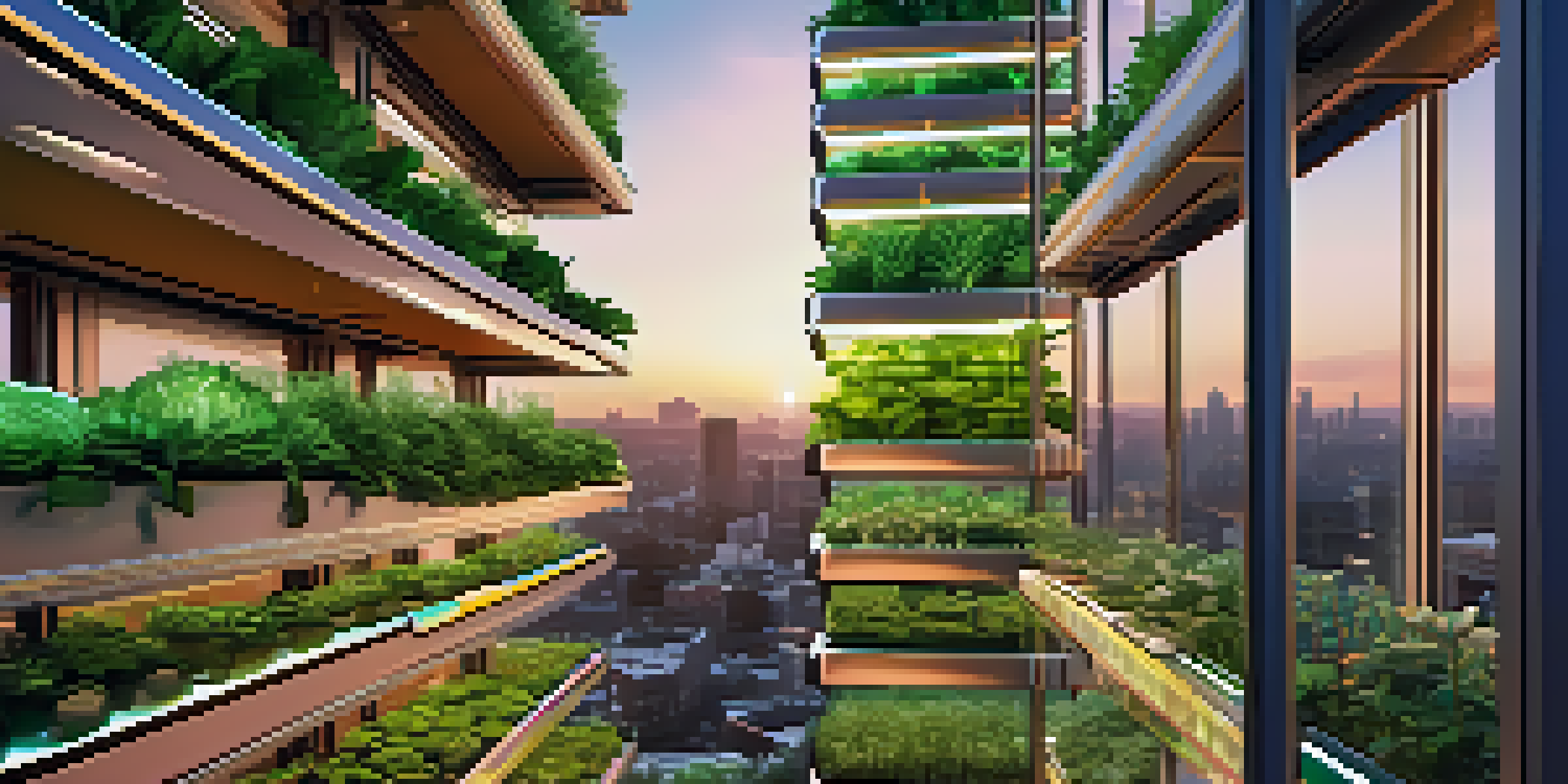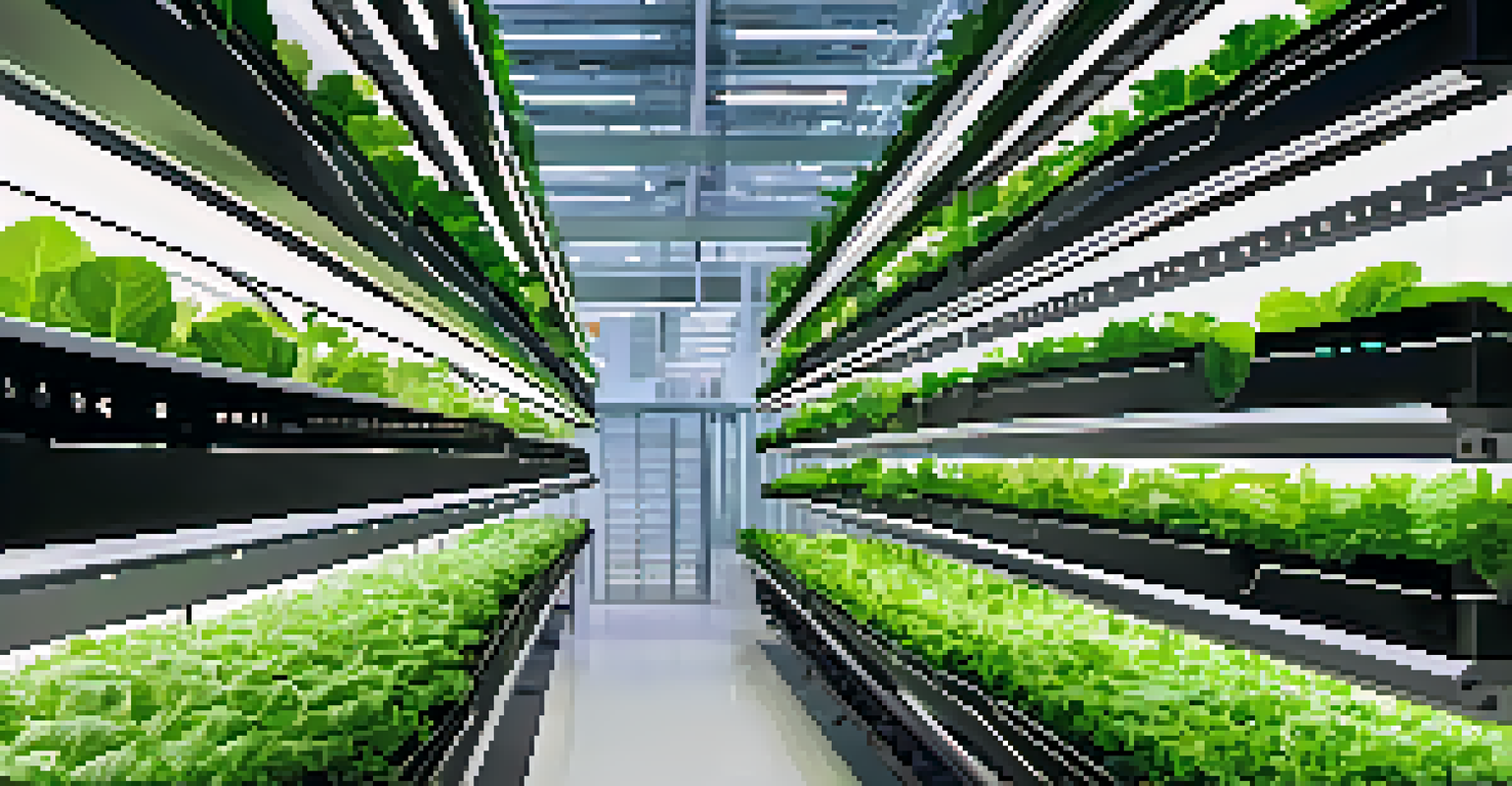Vertical Farming: Revolutionizing Urban Food Production Practices

What is Vertical Farming and Why Does It Matter?
Vertical farming is an innovative way to grow food in stacked layers, often utilizing controlled-environment agriculture (CEA). This method allows for the efficient use of space, especially in urban areas where land is scarce. As cities continue to grow, the traditional methods of farming may not suffice to meet the increasing food demands.
Vertical farming is not just a trend; it's a necessity for our urban future.
One of the key advantages of vertical farming is its ability to produce food with minimal environmental impact. By using hydroponics or aeroponics, these farms can conserve water and eliminate the need for pesticides. This not only leads to healthier crops but also reduces the carbon footprint associated with transporting food from rural farms to urban centers.
Moreover, vertical farming can contribute to food security in urban settings. With the potential to grow crops year-round, regardless of climate conditions, cities can become more self-sufficient. This approach could revolutionize how we think about food production, making it more sustainable and accessible.
The Technology Behind Vertical Farming
At the heart of vertical farming is technology, which plays a crucial role in optimizing plant growth. LED lighting systems, for instance, simulate sunlight and can be adjusted to enhance photosynthesis. This means crops can thrive indoors, even in areas where natural light is limited.

Additionally, sensors and automation are integral to managing these farms. They monitor plant health, nutrient levels, and environmental conditions, ensuring optimal growth. This tech-driven approach not only increases efficiency but also reduces labor costs, making vertical farming more economically viable.
Vertical Farming Enhances Food Security
This innovative farming method allows cities to grow food year-round, increasing self-sufficiency and reducing reliance on rural agriculture.
As technology continues to advance, we can expect even more innovations in vertical farming. From using artificial intelligence to predict crop yields to developing new growing mediums, the possibilities are endless. This constant evolution keeps vertical farming at the forefront of agricultural practices.
The Benefits of Urban Vertical Farms
Urban vertical farms offer a plethora of benefits that go beyond just food production. For one, they can significantly reduce transportation costs and emissions, as food is grown right where it's consumed. This not only shortens the supply chain but also ensures fresher produce for city dwellers.
Sustainability is about more than just conservation; it's about creating a new way of life that benefits everyone.
Moreover, these farms can contribute to the local economy by creating jobs in various fields, from technology to agriculture. As more people become interested in sustainable practices, vertical farms can also serve as educational centers, teaching communities about healthy eating and food production.
Lastly, vertical farming can enhance urban green spaces. By incorporating these farms into existing buildings or empty lots, cities can improve air quality and promote biodiversity. This integration of agriculture into urban environments fosters a sense of community and connection to nature.
Challenges Facing Vertical Farming
Despite its numerous advantages, vertical farming is not without challenges. One significant hurdle is the initial investment required to set up these high-tech farms. The cost of equipment, technology, and infrastructure can be daunting, especially for new entrepreneurs.
Another challenge lies in the energy consumption associated with vertical farming. While LED lights are energy-efficient compared to traditional lighting, maintaining the optimal climate for plant growth can still require a substantial amount of power. Finding sustainable energy sources will be crucial for the future of these farms.
Tech Drives Efficiency in Farming
Advanced technologies like LED lighting and automation optimize plant growth and reduce labor costs, making vertical farming more viable.
Finally, there is the need for public acceptance and understanding of vertical farming. Many consumers are still unfamiliar with this method of food production. Education and outreach efforts will be essential to help the public appreciate the benefits and potential of vertical farming.
Vertical Farming and Sustainability
Sustainability is at the core of vertical farming practices. By using less land and water than traditional farming methods, vertical farms can produce a higher yield of crops per square foot. This is particularly important in an era where climate change and resource depletion are pressing global issues.
Furthermore, vertical farming can help reduce food waste. Because crops can be grown in close proximity to consumers, less food is lost during transportation. Additionally, many vertical farms utilize systems that recycle water and nutrients, further minimizing waste.
With a growing emphasis on sustainable practices, vertical farming aligns perfectly with global initiatives aimed at reducing our carbon footprint. As cities continue to adopt these practices, they contribute to a healthier planet for future generations.
Case Studies: Successful Vertical Farms
Several cities around the world are already embracing vertical farming, showcasing its potential. For instance, in Singapore, the Sky Greens farm utilizes a unique A-frame design to grow vegetables efficiently in a limited space. This farm not only provides fresh produce to local markets but also serves as an inspiring example of urban agriculture.
In New York City, the farm called 'AeroFarms' has taken vertical farming to the next level by using aeroponic technology. With a focus on leafy greens, they produce over two million pounds of food annually, all while using 95% less water than traditional farming methods. Their success has sparked interest in similar ventures across the country.
Urban Farms Boost Sustainability
Vertical farms use less land and water, helping to minimize environmental impact and align with global sustainability initiatives.
These case studies illustrate that vertical farming is not just a concept; it's a viable solution to urban food challenges. As more cities invest in this innovative approach, we can expect to see a growing trend of local food production that benefits both communities and the environment.
The Future of Vertical Farming
Looking ahead, the future of vertical farming is bright and full of potential. With advancements in technology and a growing awareness of sustainability issues, we can expect more urban areas to adopt vertical farming practices. This shift may lead to increased collaboration between tech companies, farmers, and urban planners.
Moreover, as the global population continues to rise, the demand for efficient food production will only grow. Vertical farming could play a key role in addressing food shortages and ensuring that everyone has access to fresh produce. The scalability of these farms makes them an attractive solution for cities around the world.

Ultimately, the future of vertical farming is not just about food production; it's about reimagining how we interact with our urban environments. By integrating agriculture into our cities, we can create a healthier, more sustainable future for all.